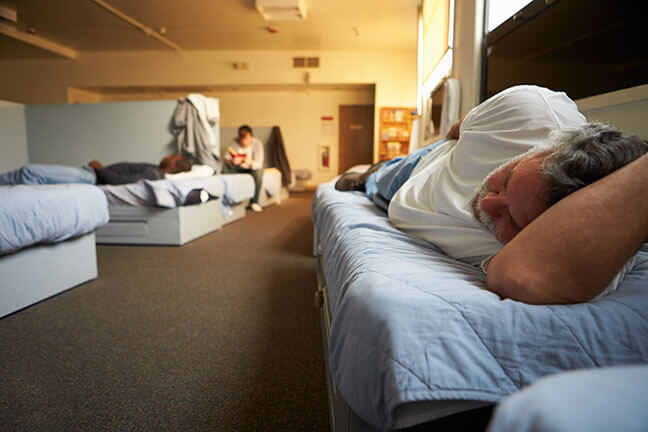If you or someone you love is currently experiencing homelessness, help is available. You don’t have to navigate this challenging situation alone. Every community has resources in place to provide emergency shelter, food, healthcare, housing assistance and support when you need it most.
This guide explains the step-by-step process to access vital services if you are searching where to go if you’re homeless. We’ll cover who to contact, what to expect during the intake process, how to obtain disability accommodations, where to find free meals and medical care, transportation options and more.
Read on to learn exactly where to go to get assistance and support if you’re experiencing homelessness.
Step 1 – Contact Local Homeless Services
The first step is to get in touch with the coordinated entry or “front door” agency for homelessness services in your area. Every community has a central organization that provides the initial intake and assessment to match individuals with appropriate housing and resources.
You can locate and visit your local coordinated entry office by:
- Calling 2-1-1
- Searching online for “[your city/county] coordinated entry homeless services”
- Contacting your county social services department
- Asking at local shelters and service providers for info
If your area doesn’t have an established coordinated entry yet, you can dial 2-1-1 or directly call shelters, food pantries, health care clinics and other organizations to explain your situation and request help.

Step 2 – The Intake Assessment Process
During intake, you’ll be asked questions to determine your current housing situation, health needs, family status, income, military service and more. This helps match you with the emergency shelter, call center, transitional housing program, or rapid rehousing services that will best meet your needs.
Be prepared to provide any medical documentation if you have a disability and need accommodations. Reasonable accommodations like accessible rooms must be granted.
If local shelters are at full capacity, you may be placed on a waiting list. But the assessment will still connect you to resources. Prioritization policies ensure the most vulnerable individuals get placed in homeless programs first when space opens up.
Step 3 – Access Food, Healthcare and Other Assistance
In addition to shelter, organizations in your local community can help with:
Applying for Supplemental Nutrition Assistance Program (SNAP)
The Supplemental Nutrition Assistance Program (SNAP), formerly known as Food Stamps, provides monthly grocery benefits on an EBT card to purchase food.
Additional Food Resources
- Find a nearby Food bank and Food pantry
- Soup kitchens and meal programs
- WIC benefits for pregnant and breastfeeding women and children under 5
You can find the resources in your area at FindHelp.org
Healthcare
- Health clinics providing free or low-cost medical care, including mobile clinics
- Mental health resources offering counseling, addiction treatment, crisis support
- Prescription assistance and medication clinics
- Free Dental Clinics
- Seniors and those that qualify for Medicare and Medicaid should check if DSNP plans (which provide extra benefits) are available in the area
Additional Services
- Rental and utilities assistance
- Help applying for income support benefits
- Life skills, GED, and employment readiness classes
- Veteran services
- Domestic violence resources
- Disability services
- Free legal aid

Step 4 – Arranging Transportation to Shelter
If placed in an emergency shelter, you’ll need to get yourself to the facility. Some options for arranging transportation include:
- Public buses or trains – Many communities offer free or discounted transit passes to individuals in shelters or transitional housing.
- Shelter van pick-ups – Some shelters have scheduled pick-up times and locations.
- Outreach staff assistance – Case managers may be able to assist with travel arrangements.
- Rideshares or taxis – You may qualify for vouchers to cover ride fares.
Discuss your transportation situation during intake and with shelter staff. They’ll advise the best options based on your mobility and location.
Step 5 – Access Lifeline & ACP Through EASY Wireless
Getting free cell phone service and data can also provide families a vital lifeline when experiencing homelessness. Federal programs called Lifeline and the Affordable Connectivity Program (ACP) provide free mobile plans including unlimited talk, text, and data through providers like EASY Wireless.
Having a phone assists with job searches, accessing social services and benefits, and staying connected with housing contacts.
Learn more about checking your eligibility for free wireless service at EASY Wireless.
National Organizations That Can Help
In addition to local service providers, national community organizations, like these can offer various forms of aid to those experiencing homelessness and housing instability. They have branches throughout the U.S. and can be a source to receive help from housing to food and job searches. :
- The Salvation Army – https://www.salvationarmyusa.org/usn/
- Goodwill Industries – https://goodwill.org/
- Habitat for Humanity – https://www.habitat.org/
- United Way – https://www.unitedway.org/
Housing Assistance and Long-Term Solutions
Once you’ve entered an emergency shelter, meet with case managers to discuss more permanent housing options. They can help create a long-term plan and assist with:
- Rental assistance programs like Section 8 housing vouchers – These provide long-term subsidized housing to low-income individuals and families.
- Rapid rehousing programs – These quickly move people from shelters into permanent housing with temporary rental assistance.
- Transitional housing – Some programs offer transitional housing for 6 months to 2 years with supportive services.
- Permanent supportive housing – These provide affordable housing paired with mental health, employment, or other supportive services.
- Income support benefits – Case managers can help apply for Social Security, disability benefits and other income streams.
- Savings programs – Some shelters have programs to help residents build savings for security deposits, moving costs, etc.
The goal is to get you back into safe and stable housing. Be open about your needs so case managers can connect you with the best resources.
Finding help is the first step to getting back on your feet. Don’t wait. Reach out today.
No one wants to experience homelessness. But if you find yourself facing housing loss or instability, immediately contact local homeless services for support. Follow the steps covered in this guide to access emergency shelter, food, medical care and income assistance in your community.
With compassionate guidance from frontline staff, you can work toward securing safe and stable, affordable housing once again. Small steps make a big difference. Don’t go without basic necessities – get the help you need today.


